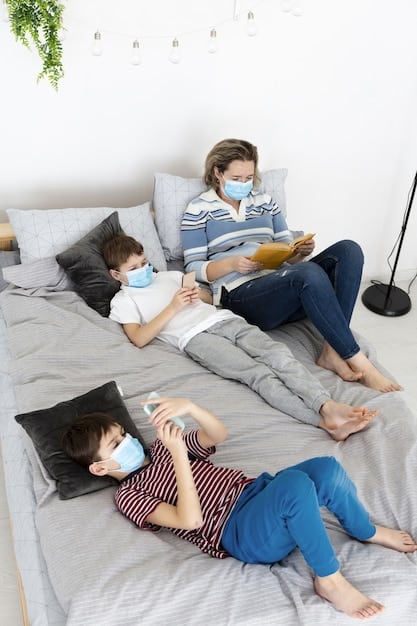FDA Approves New Sleep Aid for Children with Insomnia (2025)

Recent Updates: FDA Approves New Sleep Aid for Children with Insomnia (2025) bringing a new treatment option for pediatric insomnia, offering hope for improved sleep quality and overall well-being for children struggling with this condition.
The landscape of pediatric sleep medicine has recently seen a significant development. Recent Updates: FDA Approves New Sleep Aid for Children with Insomnia (2025), marking a crucial advancement in addressing sleep disturbances in young patients.
Understanding Pediatric Insomnia
Pediatric insomnia is a widespread issue that affects the lives of numerous children and their families. It involves difficulties in falling asleep, staying asleep, or experiencing restful sleep.
Recognizing the symptoms, understanding the root causes, and exploring the recent FDA approval that brings promise for a significant change in this area are key to addressing this pervasive issue effectively.
Symptoms of Pediatric Insomnia
Identifying pediatric insomnia involves recognizing a range of symptoms. Here’s what to look out for:
- Difficulty falling asleep at bedtime
- Frequent awakenings during the night
- Resistance to going to bed
- Daytime behavioral issues, such as irritability or hyperactivity
Causes of Sleep Disorders
Several factors can contribute to insomnia in children. Identifying the underlying cause is important for effectively addressing the problem. Here’s an overview:
- Stress and anxiety
- Inconsistent sleep schedules
- Poor sleep hygiene
- Underlying medical conditions
In conclusion, understanding the multifaceted nature of pediatric insomnia is essential for parents and healthcare providers alike. Addressing the symptoms and causes may lead to the long-term wellness of children suffering from this disorder.

The Significance of FDA Approval
The recent FDA approval of a new sleep aid is a watershed moment for children with insomnia and their families. This milestone represents a rigorous scientific evaluation, assuring that the treatment is both safe and effective for pediatric use.
The path involved in getting FDA approval encompasses several phases of testing and inspections. This involves stringent requirements and regulatory evaluation by the Food and Drug Administration. Let’s delve into the importance and impact of this approval.
Rigorous Testing and Evaluation Process
The FDA approval process is comprehensive and ensures that only safe and effective medications are available to the public. Here’s what the process involves:
- Preclinical testing to assess safety and potential side effects
- Clinical trials to evaluate efficacy in humans
- Review of manufacturing processes to ensure quality control
This approval signifies that the sleep aid has met rigorous standards and is deemed safe and effective for use in children with insomnia.
Impact on Pediatric Sleep Medicine
The approval of a new sleep aid has significant implications for the field of pediatric sleep medicine:
- Provides a much-needed treatment option for children with sleep disorders
- Encourages further research and innovation in pediatric sleep medicine
- Offers hope to families struggling with sleepless nights
In conclusion, the FDA approval is a monumental step forward in addressing pediatric sleep disorders. It highlights the capability of scientific research and regulatory oversight to deliver effective and safe solutions for children in need.
Details about the New Sleep Aid
The newly approved sleep aid marks a significant development in the treatment of pediatric insomnia. Understanding its mechanism of action and formulation is crucial for healthcare providers and parents alike.
The newly approved sleep aid offers a novel approach to tackling insomnia in children. Its innovative components and precise formulation make it a game-changer in pediatric sleep medicine. Let’s uncover the critical details.
Innovative Formulation
The formulation of the new sleep aid is one of its key differentiators. The compound and delivery system have been designed to address the unique physiological needs of children with insomnia.
- Specially formulated for pediatric use, ensuring appropriate dosing and safety
- Easy-to-administer formulation, such as a chewable tablet or liquid
- Hypoallergenic and free from common allergens
Mechanism of Action
The new sleep aid works by targeting specific pathways in the brain that regulate sleep. By influencing these pathways, the sleep aid can help improve sleep onset, duration, and quality.
- Regulates neurotransmitters involved in sleep
- Helps calm overactive minds and reduce anxiety
- Encourages a more natural sleep-wake cycle
In sum, the introduction of this new sleep aid symbolizes a remarkable advancement in pediatric sleep medicine. Healthcare providers and parents can now leverage its distinctive formulation and mechanism of action to successfully manage insomnia in children.

How to Use the New Sleep Aid Safely
The newly FDA-approved sleep aid provides a beacon of hope for children struggling with insomnia and their concerned families. However, it’s paramount to use this treatment safely and judiciously.
Adhering to guidelines, being aware of potential side effects, and managing the medication responsibly can reduce risks. Let’s delve into the important safety measures.
Dosage Guidelines
Following the recommended dosage guidelines is crucial to ensure the safety and effectiveness of the sleep aid. Healthcare providers will determine the appropriate dosage based on factors such as age, weight, and severity of insomnia.
- Administer the sleep aid at bedtime, as directed by a healthcare provider
- Avoid exceeding the recommended dosage
- Monitor for any adverse reactions or side effects
Potential Side Effects and Precautions
Like all medications, the new sleep aid may cause side effects in some individuals. Being aware of these potential side effects and taking appropriate precautions is important for minimizing risks.
- Common side effects may include drowsiness, dizziness, or headache
- Serious side effects are rare but should be reported to a healthcare provider immediately
- Avoid combining the sleep aid with other medications or substances that may cause drowsiness
In summary, the safe and rational use of the newly approved sleep aid is paramount for optimizing its benefits and minimizing potential risks. A partnership between healthcare providers, parents, and caregivers is essential to achieve successful treatment outcomes. Proper dosage guidelines, awareness of potential side effects, and diligent monitoring can contribute to a secure and successful therapeutic experience.
Integrating the Sleep Aid into a Comprehensive Treatment Plan
The introduction of the new FDA-approved sleep aid marks a notable advancement in the treatment of pediatric insomnia. Integrating it into a comprehensive treatment plan is essential to ensure optimal results.
This can involve additional strategies, creating a holistic approach that tackles the fundamental reasons for sleeplessness, and promotes long-term sleep health. Let’s look at this integrated approach more closely.
Behavioral Therapies and Sleep Hygiene Practices
Behavioral therapies, such as cognitive-behavioral therapy for insomnia (CBT-I), can be highly effective in addressing the underlying causes of insomnia and improving sleep habits. Combining medication with behavioral interventions can lead to better outcomes.
- Establish a consistent sleep schedule
- Create a relaxing bedtime routine
- Optimize the sleep environment by ensuring it is dark, quiet, and cool
Addressing Underlying Medical Conditions
In some cases, insomnia may be secondary to an underlying medical condition, such as asthma, allergies, or sleep apnea. Addressing these conditions can help alleviate insomnia symptoms.
- Work with a healthcare provider to manage any underlying medical conditions
- Ensure that medications are not interfering with sleep
- Consider alternative treatments, such as nasal decongestants or allergy medications
In conclusion, the successful integration of the new sleep aid into an extensive treatment strategy signifies a transformative shift towards thorough pediatric insomnia management. By including behavioral therapies, sleep hygiene practices, and addressing underlying medical conditions, healthcare providers and parents can encourage long-term sleep health in children.
Future Directions and Research
The FDA approval of a novel sleep aid for children with insomnia represents a significant milestone and ignites optimism for enhanced treatments in the future.
As research progresses, new paths are opening up, promising even more successful and tailored treatments. Let’s delve into emerging trends in sleep medicine and future research directions.
Ongoing Clinical Trials and Studies
Ongoing clinical trials and studies are exploring new and innovative approaches to treating pediatric insomnia. These studies aim to evaluate the safety and efficacy of different interventions and refine treatment protocols.
- Researching personalized approaches to insomnia treatment
- Investigating the role of genetics in sleep disorders
- Exploring the potential of digital health technologies for remote monitoring and intervention
Emerging Trends in Sleep Medicine
The field of sleep medicine is constantly evolving, with new technologies and therapies emerging to address sleep disorders. These trends have the potential to revolutionize the way pediatric insomnia is diagnosed and treated.
- Telemedicine for remote consultations and monitoring
- Wearable sleep trackers for assessing sleep patterns
- Artificial intelligence for analyzing sleep data and predicting treatment outcomes
In summary, the area of pediatric insomnia treatment is set to evolve significantly in the coming years, driven by ongoing research and emerging trends in sleep medicine. These progressions promise to usher in a future where more effective and customized interventions are available, ultimately enhancing the quality of life for children and families dealing with insomnia.
| Key Point | Brief Description |
|---|---|
| ✨ FDA Approval | New sleep aid approved for children with insomnia. |
| 🔬 Formulation | Specially designed for pediatric use, easy to administer. |
| 😴 Safe Usage | Follow dosage guidelines and monitor for side effects. |
| 🧑⚕️ Comprehensive Plan | Combine with behavioral therapies for better outcomes. |
Frequently Asked Questions
Pediatric insomnia is a sleep disorder that affects children, making it difficult to fall asleep, stay asleep, or get restful sleep. It can lead to daytime behavioral issues and affect overall health.
The new sleep aid works by targeting specific pathways in the brain that regulate sleep. It influences neurotransmitters to improve sleep onset, duration, and quality, promoting a more natural sleep.
Common side effects may include drowsiness, dizziness, or headache. Serious side effects are rare but should be reported to a healthcare provider immediately. Always monitor your child carefully.
Combine the sleep aid with behavioral therapies, consistent sleep routines, and a conducive sleep environment. Also, address any underlying medical conditions contributing to the sleep disorder for best results.
Future research includes personalized treatments, genetics, and digital health technologies for remote monitoring. Telemedicine, wearable trackers, and AI will improve pediatric insomnia management greatly .
Conclusion
In conclusion, the FDA approval of a new sleep aid for children with insomnia marks a significant step forward in pediatric sleep medicine. By understanding the symptoms and causes of insomnia, using the new aid safely, and integrating it into a comprehensive treatment plan, families can look forward to improved sleep and better overall health for their children.





